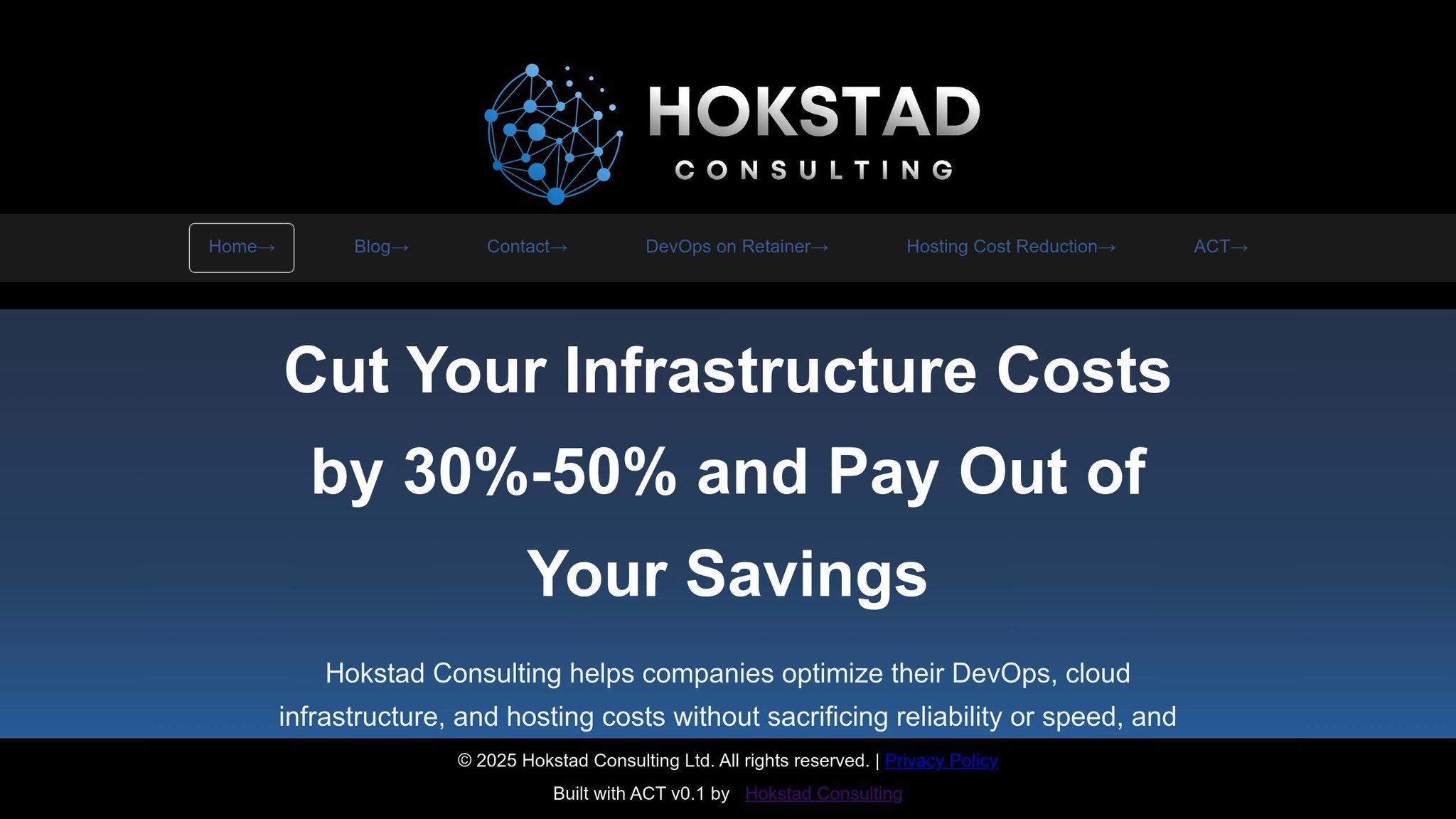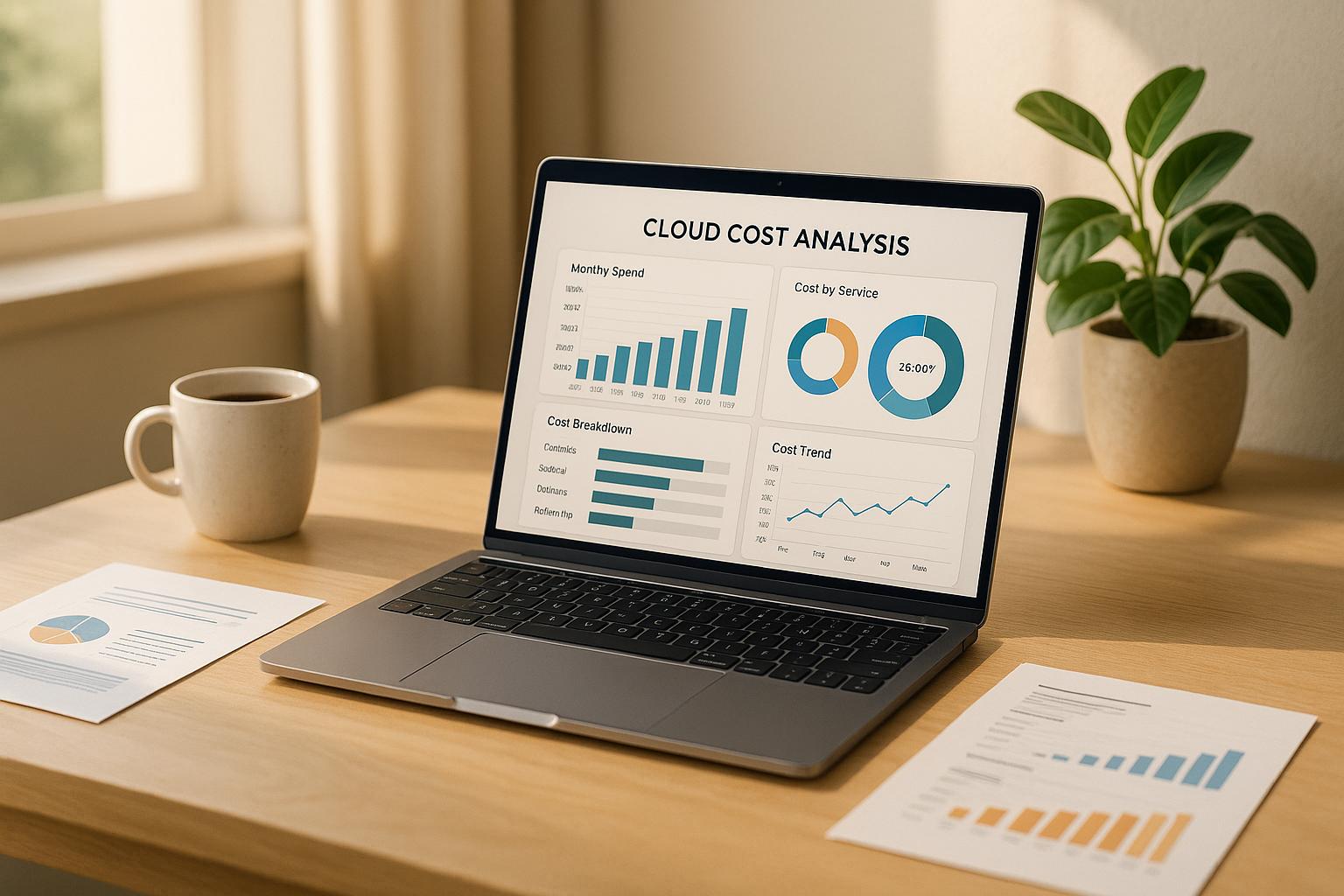82% of UK business leaders are worried about managing cloud costs effectively - and for good reason. With 32% of cloud spending wasted in 2022, benchmarking your cloud costs is no longer optional. Here's what you need to know:
- What is Cloud Cost Benchmarking? It's the process of comparing your cloud spending, resource usage, and performance against industry standards to uncover inefficiencies and optimise costs.
- Why It Matters: Businesses have saved up to £800,000 annually by identifying waste and reallocating resources.
- Key Metrics to Track: Cost per workload, resource utilisation rates, efficiency ratios, and cost predictability.
- Top Tools to Use: Platforms like CloudZero, nOps, and Cast AI provide automation, multi-cloud support, and actionable insights to optimise cloud spending.
- Best Practices: Set baseline metrics, automate reporting, and regularly audit costs to reduce waste and improve efficiency.
Quick Comparison of Benchmarking Tools:
| Tool | Multi-Cloud Support | Automation Level | Pricing | Key Feature |
|---|---|---|---|---|
| CloudZero | AWS, Azure, GCP | High | Custom pricing | Links costs to business goals |
| nOps | AWS only | Very High | Not disclosed | Automated cost optimisation |
| Cast AI | Kubernetes focus | Very High | Not disclosed | Kubernetes cost savings |
| AWS CloudWatch | AWS only | Medium | Not disclosed | Basic AWS integration |
| ProsperOps | Google Cloud | Very High | Not disclosed | Automated discount management |
| CoreStack | AWS, Azure, GCP | High | £39.39/month | Multi-cloud governance |
| Hyperglance | Multi-cloud | Medium | £1,171+/month | Visual cloud mapping |
Why Act Now: With fewer than 20% of UK companies reaching mature cloud adoption, optimising costs gives you a competitive edge. Start benchmarking today to save money, improve performance, and make smarter decisions.
Key Concepts and Metrics in Cloud Cost Benchmarking
What is Cloud Cost Benchmarking?
Cloud cost benchmarking is the process of systematically comparing your organisation's cloud spending, resource usage, and performance against industry standards. By analysing data across services, departments, and projects, you can determine whether your expenditures are efficient and identify areas for potential savings. For instance, if your monthly cloud bill totals £50,000, comparing it with similar-sized businesses provides valuable context for making cost-saving decisions.
The real value of benchmarking lies in this context. Without clear benchmarks, it's hard to tell whether your spending is efficient or if you're overspending. Below, we explore the essential metrics that underpin effective benchmarking.
Key Metrics for Benchmarking
To measure spending efficiency and identify opportunities for improvement, focus on these key metrics:
Cost per workload: This metric evaluates how much you're spending to run specific applications, services, or business functions in the cloud. For example, if your e-commerce platform costs £15,000 per month and processes 100,000 transactions, your cost per transaction is £0.15. Benchmarking this figure helps assess whether your infrastructure is cost-efficient.
Resource utilisation rates: This measures how effectively you're using the cloud resources you're paying for, such as CPU, memory, storage, or network bandwidth. Low utilisation often signals over-provisioned instances or unused resources.
Efficiency ratios: These combine cost and performance data to highlight the value derived from your cloud investment. Examples include cost per user served, revenue generated per pound spent on cloud services, or processing capacity per unit of cost. These ratios provide insight into the business impact of your spending.
Cost predictability: This tracks how consistent and forecastable your cloud expenses are over time. By monitoring month-to-month fluctuations, seasonal trends, and the split between predictable and variable costs, you can improve cost control and planning. High predictability often reflects better financial management.
Benefits of Industry Standard Comparisons
Benchmarking your cloud costs against industry standards offers more than just cost-cutting opportunities - it can reshape your organisation's approach to cloud financial management and strategic planning.
By comparing metrics to industry benchmarks, organisations can optimise their cloud infrastructure, reduce unnecessary spending, and align their cloud investments with broader business goals. For example, assessments and advanced analytics can help improve budget compliance, streamline operations, and ensure that every pound spent supports business objectives [1][2].
Another advantage is the ability to make proactive budget adjustments and forecasts. Benchmarking can also strengthen your position when negotiating contracts with cloud service providers [5].
The financial implications are significant. In 2022, it was estimated that 32% of cloud spending was wasted [4]. By adopting effective benchmarking practices, UK businesses can uncover and eliminate this waste, leading to substantial savings.
Perhaps the most impactful aspect of benchmarking is its role in supporting the FinOps approach. FinOps brings IT, Finance, and Operations teams together to make data-driven decisions and improve accountability for cloud spending [3]. This collaboration helps teams balance cost, speed, and quality when managing their digital environments and investments [3].
Top Tools for Cloud Cost Benchmarking
Overview of Benchmarking Tools
Choosing the right tool for cloud cost benchmarking is a critical step in managing and optimising your cloud expenses. With advancements in technology, many platforms now go beyond simple dashboards, offering detailed insights into usage patterns and even automating cost-saving measures.
CloudZero brings a unique edge by connecting cloud spending to business outcomes. It breaks down costs to show where, when, and how resources are being used. This approach has delivered tangible results, like helping Drift save £4 million on AWS and enabling Ninjacat to cut their cloud costs by 40% [10].
nOps, a highly rated solution on G2 [6], excels in automated optimisation and offers a clear view of AWS environments. It helps businesses identify waste, which can account for up to 32% of cloud budgets [10].
Cast AI focuses on Kubernetes cost optimisation and boasts a 4.8/5 rating from over 50 reviews [7][9]. A practical example of its effectiveness is PlayPlay, which saved around £1,148 per month by shifting Kubernetes workloads to more cost-efficient instances without service disruption [9].
AWS CloudWatch, as a native AWS tool, offers basic monitoring, cost tracking, and alerting features. However, it lacks the advanced automation and recommendations available in specialised platforms [6].
ProsperOps takes a different approach by automating Google Cloud discount optimisation. This reduces manual effort and ensures ongoing cost efficiency [11].
Pricing for these tools varies widely. For instance, Uptrends starts at £14.07 per month, making it a budget-friendly option. On the other end, enterprise-level solutions like CloudEagle.ai cost approximately £1,607 per month. Mid-range options include CoreStack (£39.39 per month) and Azure Costs (£23.31 per month), offering balanced features suited for growing businesses [8].
These platforms empower organisations to make informed decisions, helping to manage and optimise cloud spending effectively.
Comparison of Benchmarking Tools
When choosing a cloud cost benchmarking tool, businesses in the UK need to consider several factors, such as multi-cloud support, automation capabilities, and pricing. Here's a quick comparison of leading platforms:
| Tool | Multi-Cloud Support | Automation Level | Pricing | Key Strength |
|---|---|---|---|---|
| CloudZero | AWS, Azure, GCP | High | Custom pricing | Links costs to business goals |
| nOps | AWS focused | Very High | Not disclosed | Highly rated on G2 |
| Cast AI | Kubernetes focus | Very High | Not disclosed | Kubernetes cost optimisation |
| AWS CloudWatch | AWS only | Medium | Not disclosed | Seamless AWS integration |
| ProsperOps | Google Cloud | Very High | Not disclosed | Automated discount management |
| CoreStack | AWS, Azure, GCP | High | £39.39 monthly | Multi-cloud governance |
| Hyperglance | Multi-cloud | Medium | £1,171+ monthly | Visual cloud mapping |
Automation is a key differentiator. Tools like Cast AI and ProsperOps automatically apply cost-saving measures, a crucial feature given that 82% of IT professionals identify cloud costs as a top challenge [6].
Integration is another important factor. Native tools like AWS CloudWatch integrate seamlessly within their ecosystems but may lack the cross-platform visibility needed by multi-cloud setups. Third-party platforms often offer broader integration but might require additional configuration.
Reporting and forecasting capabilities also vary. Advanced tools provide predictive analytics to help businesses anticipate future costs, while simpler platforms mainly focus on historical and current data.
For UK companies, evaluating the total cost of ownership is essential. Beyond subscription fees, consider implementation, training, and maintenance costs to ensure the tool aligns with your current cloud infrastructure and can scale as your organisation grows.
Ultimately, the goal is to choose a platform that delivers actionable insights, enabling smarter decisions about cloud investments rather than just presenting data in visual formats.
Techniques and Best Practices for Effective Benchmarking
Setting Up Baseline Metrics
Establishing solid baseline metrics is the backbone of effective cloud cost benchmarking. Begin by gathering billing and usage data from all cloud environments. Ensure consistent resource tagging across the board and analyse spending trends to pinpoint the main cost drivers. Simple unit metrics, such as cost per GB or cost per compute unit, provide quick and actionable insights. It’s also important to involve key stakeholders - engineering, finance, and leadership teams - to review these spending patterns and build accountability across departments [12]. Once these metrics are in place, the process becomes smoother, especially when automation is introduced to simplify cost monitoring.
Using Automation and Reporting
Automation takes the headache out of manual benchmarking, turning it into an efficient system that offers real-time visibility for tracking and optimising costs [13]. For instance, Complyt managed to slash its AWS costs by 40% in just one hour using an integrated tool, while Stitch Fix saved significantly by fine-tuning cost attribution across multiple accounts [14]. Automating tagging is key for consistent cost allocation, and using platforms that normalise data across multi-cloud setups can be a game-changer. Before choosing automation tools, take a step back and define your priorities. Think about integration capabilities, how much control you need, and whether you prefer tools that make recommendations or fully automate processes. Automated tagging and approval workflows ensure governance stays intact. According to the FinOps Foundation's 2025 State of FinOps Report, more than half of respondents ranked waste reduction as their top priority - a need that automated tools address by continuously monitoring unused resources [13]. With these processes in place, you’ll be ready for a deeper dive into cost optimisation.
Analysing Results for Cost Optimisation
The key to effective cost optimisation lies in systematically identifying inefficiencies across major expense areas like storage, compute, support, managed services, and data transfer costs [15]. Regular billing reviews can help you catch hidden fees early, while budgets and alerts act as safeguards against unexpected expenses. To maximise efficiency, right-size resources based on actual usage, eliminate unused assets, and schedule shutdowns during periods of inactivity. Discount strategies, such as Reserved Instances (offering savings of up to 72%) and Spot Instances (up to 90% savings for interruptible tasks), can significantly reduce costs [15]. Storage costs can also be optimised by selecting the right tiers for access frequency and automating data movement policies.
With poor resource utilisation contributing to an average of 30% cloud overspend [16], implementing chargeback mechanisms for accountability is crucial. Regular audits can uncover idle resources, ensuring nothing goes to waste. It’s worth noting that downtime can cost small businesses up to £427 per minute, while larger enterprises may lose as much as £1 million per hour [15]. This makes performance monitoring just as important as cost savings. By focusing on these strategies and tying them back to the baseline metrics you’ve established, you can achieve measurable financial efficiency.
Need help optimizing your cloud costs?
Get expert advice on how to reduce your cloud expenses without sacrificing performance.
Hokstad Consulting's Cloud Cost Benchmarking Services

Custom Benchmarking Solutions
Hokstad Consulting offers a personalised approach to cloud cost benchmarking, recognising that every UK business has its own infrastructure needs. Instead of relying on generic methods, they create bespoke benchmarking strategies tailored for public, private, and hybrid cloud environments. Their cloud cost engineering includes setting up detailed monitoring and tagging systems, ensuring precise cost tracking and analysis [18].
The process begins with a comprehensive review of your cloud setup. This involves analysing spending patterns and identifying key metrics that align cloud expenses with your business objectives. Hokstad Consulting works collaboratively with teams across IT, finance, and operations to ensure these benchmarks are meaningful and actionable.
To streamline the process, they use specialised software to automate data collection and analysis. Their focus is on benchmarks that directly influence business performance - like cost per transaction or cost per user - so the insights gained lead to tangible improvements.
Hokstad Consulting also excels in tiered data management, following best practices to balance cost and complexity. Felicia Dorng from Cribl summarises this approach:
Tiered data management is about balancing cost and complexity [18].
By applying this principle, Hokstad Consulting helps businesses implement the correct storage tiers, automate data movement policies, and develop cost allocation strategies that reflect actual usage. This meticulous, tailored approach is aimed at achieving measurable cost reductions.
Proven Cost Savings Results
Hokstad Consulting’s customised benchmarking strategies have delivered impressive results, often reducing infrastructure costs by 30%-50% for their clients [17]. These savings come from identifying inefficiencies in key expense areas such as storage, compute, support, managed services, and data transfer costs.
Their approach involves optimising resources based on usage data, eliminating unused assets, and scheduling downtime during periods of inactivity. They also maximise savings by utilising Reserved Instances and Savings Plans.
What sets Hokstad Consulting apart is their risk-free cost optimisation model. Fees are capped as a percentage of the savings achieved, meaning you only pay when you see actual results [17]. The process starts with a free assessment of your current cloud setup, where spending patterns are analysed to uncover specific cost-saving opportunities [17].
Beyond initial savings, Hokstad Consulting provides ongoing support, including budget management, alert systems, and regular audits to ensure cloud costs remain aligned with your business's growth.
A Look at Intuit's Cloud Cost Optimization and FinOps Best Practices

Conclusion
As cloud spending continues to rise, cloud cost benchmarking has become essential for UK businesses aiming to manage their budgets effectively. According to Gartner, global end-user spending on public cloud services is projected to grow by 21.7% in 2023, reaching US$597.3 billion (around £480 billion). Alarmingly, surveys suggest that 30% of cloud investments are wasted, with 32% of spending being deemed inefficient in 2022 [19][4].
Benchmarking offers a practical way to ensure businesses pay competitive rates for their cloud services. By comparing costs against industry standards, companies can uncover areas of waste, overprovisioning, and inefficiencies. The FinOps approach - fostering collaboration between engineering, finance, and business teams - has proven especially effective in enabling data-driven decisions around cloud expenditure [19].
The tools and strategies highlighted in this discussion provide UK businesses with various options, from detailed market analyses to automated monitoring systems. However, adopting these solutions requires not only technical know-how but also a sustained commitment to optimisation. This is where Hokstad Consulting stands out. Their tailored benchmarking strategies are designed to meet specific business goals and have a proven track record of delivering measurable results. For instance, they have successfully reduced infrastructure costs by 30%–50% [18]. Their risk-free model, which ensures payment only upon achieving results, makes cost optimisation accessible to organisations of all sizes.
Cloud cost benchmarking is more than just a cost-cutting exercise - it’s a way to turn unchecked expenses into a competitive edge. By aligning spending with industry standards and leveraging the right tools, UK businesses can channel their cloud investments into opportunities for growth and innovation.
FAQs
How does cloud cost benchmarking help organisations manage their finances more effectively?
Cloud cost benchmarking provides organisations with a clear understanding of how their cloud spending stacks up against industry norms or similar companies. This perspective makes it easier to pinpoint inefficiencies, streamline spending, and manage resources more wisely.
By using benchmarking strategies, businesses can establish practical financial goals, cut down on wasteful expenses, and ensure their cloud investments align with their broader objectives. This not only boosts return on investment but also promotes financial stability and enables smarter choices that support sustainable growth over time.
What are the best strategies for establishing baseline metrics in cloud cost benchmarking?
To set up meaningful baseline metrics for cloud cost benchmarking, the first step is to take a deep dive into your current infrastructure. Analyse how resources are being used and what costs are tied to them. This evaluation helps pinpoint inefficiencies and lays the groundwork for making improvements.
Once that's done, establish specific benchmarks that reflect your business objectives. Make sure to involve all relevant stakeholders in the process to ensure everyone is on the same page. Techniques like right-sizing your resources and keeping a close eye on utilisation are key to building accurate baselines and tracking changes over time.
By following these steps, you can not only manage your spending better but also keep your cloud infrastructure adaptable and cost-effective as your business grows.
How can automated tools help businesses reduce cloud costs and improve efficiency?
Automated tools play a crucial role in cutting down cloud expenses while boosting efficiency. They come equipped with features like detailed cost tracking, resource rightsizing, and automated optimisation, which help businesses identify unnecessary spending, assign resources wisely, and make smarter, data-backed decisions to manage costs.
Take, for instance, tools that leverage advanced technologies like AI. These can forecast costs, track usage in real-time, and automatically adjust resources to meet fluctuating demand. By simplifying these tasks, businesses not only save money but also ensure smooth operations and maintain top-notch performance.
